Cite this document
(Skills of Clinical Supervision for Nurses Research Paper, n.d.)
Skills of Clinical Supervision for Nurses Research Paper. Retrieved from https://studentshare.org/nursing/1828289-introduction-to-clinical-supervision
Skills of Clinical Supervision for Nurses Research Paper. Retrieved from https://studentshare.org/nursing/1828289-introduction-to-clinical-supervision
(Skills of Clinical Supervision for Nurses Research Paper)
Skills of Clinical Supervision for Nurses Research Paper. https://studentshare.org/nursing/1828289-introduction-to-clinical-supervision.
Skills of Clinical Supervision for Nurses Research Paper. https://studentshare.org/nursing/1828289-introduction-to-clinical-supervision.
“Skills of Clinical Supervision for Nurses Research Paper”, n.d. https://studentshare.org/nursing/1828289-introduction-to-clinical-supervision.


